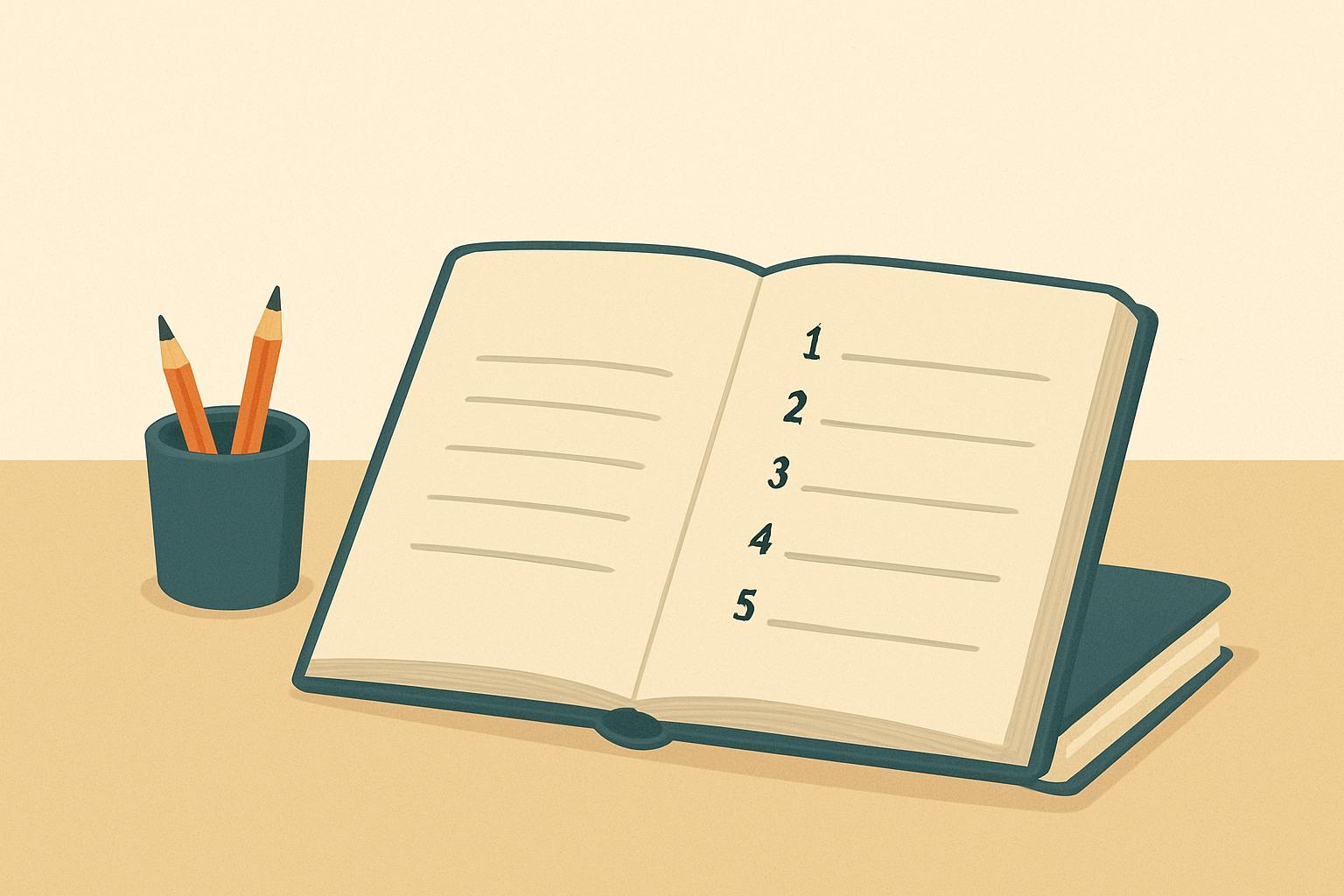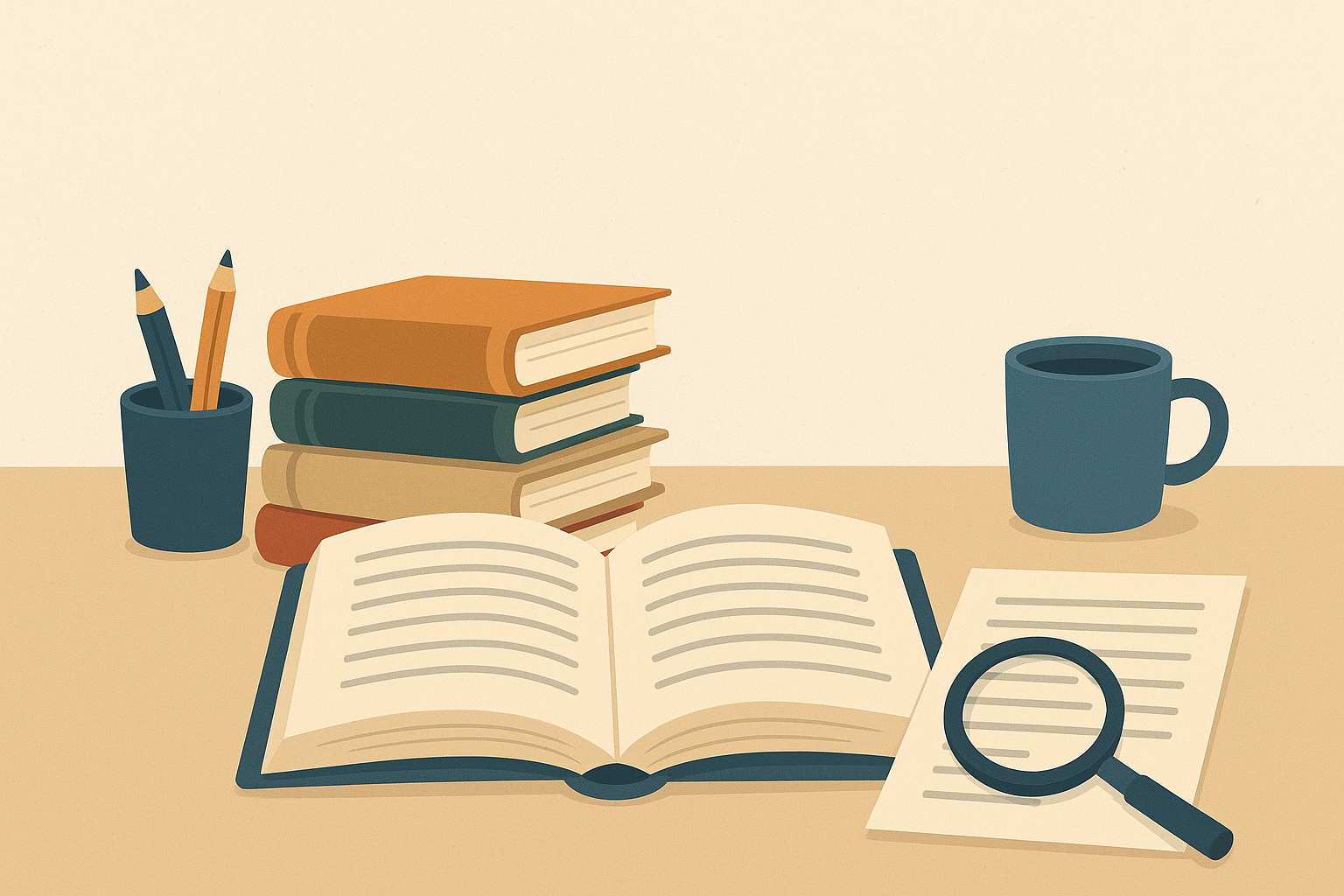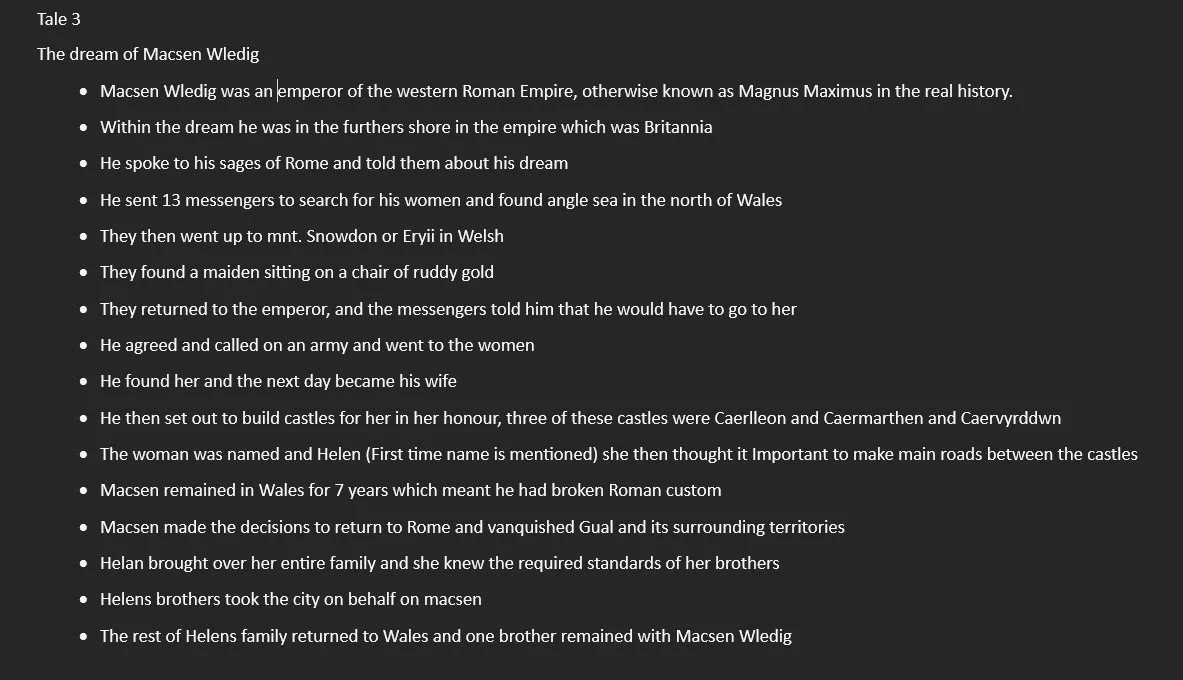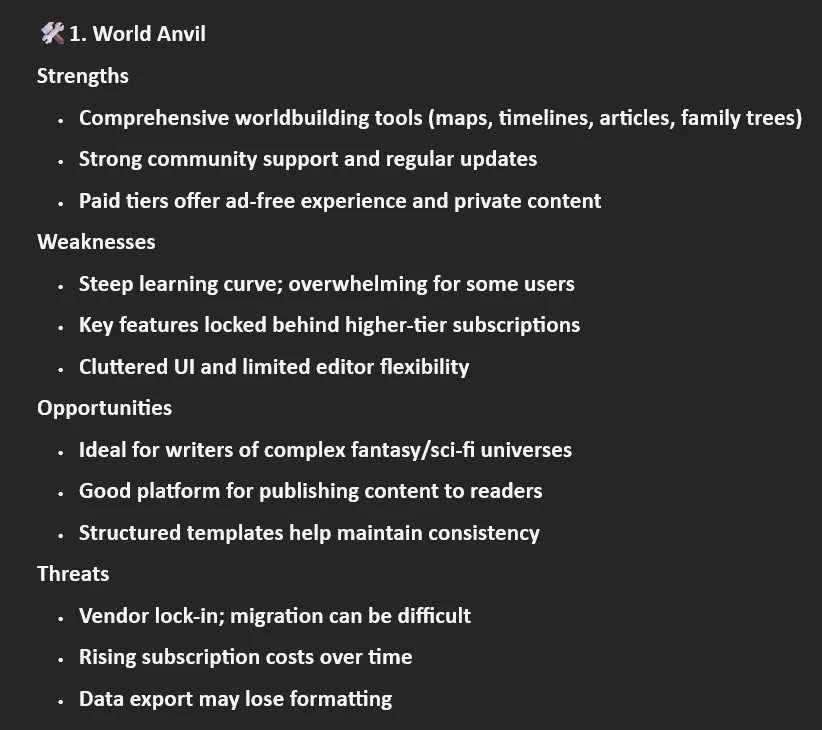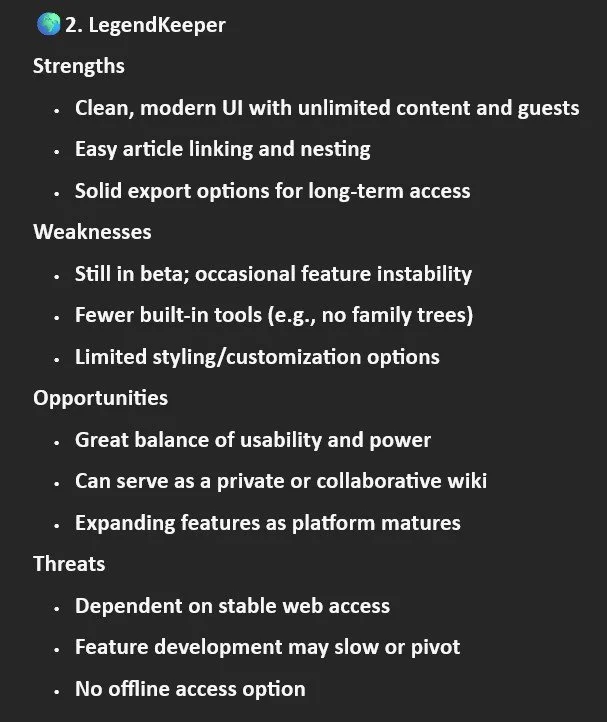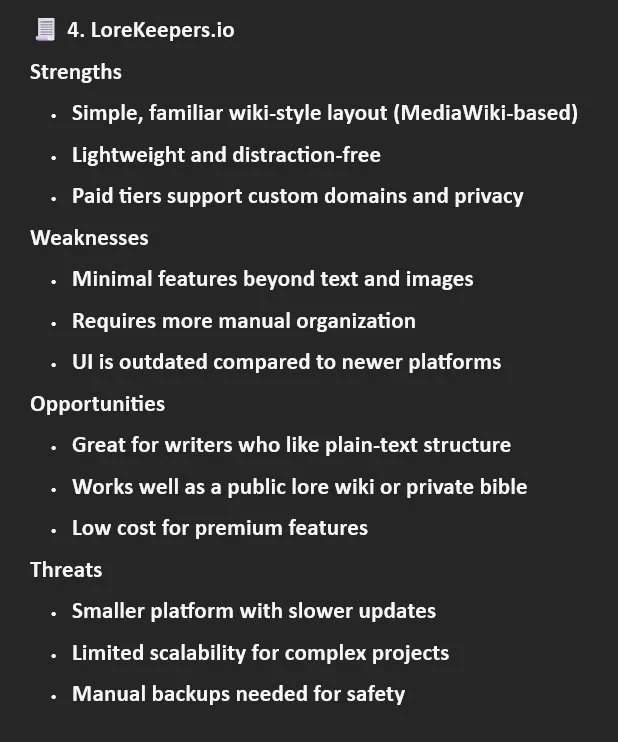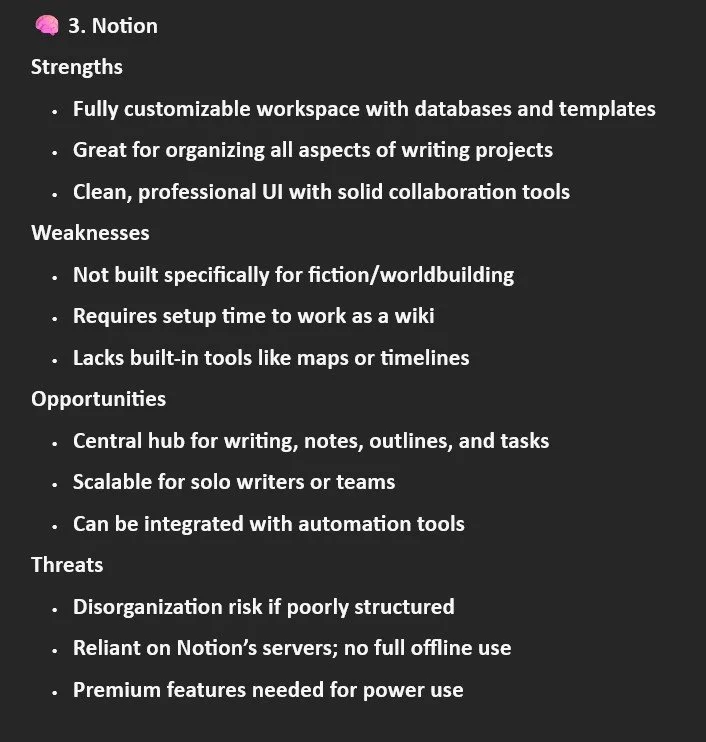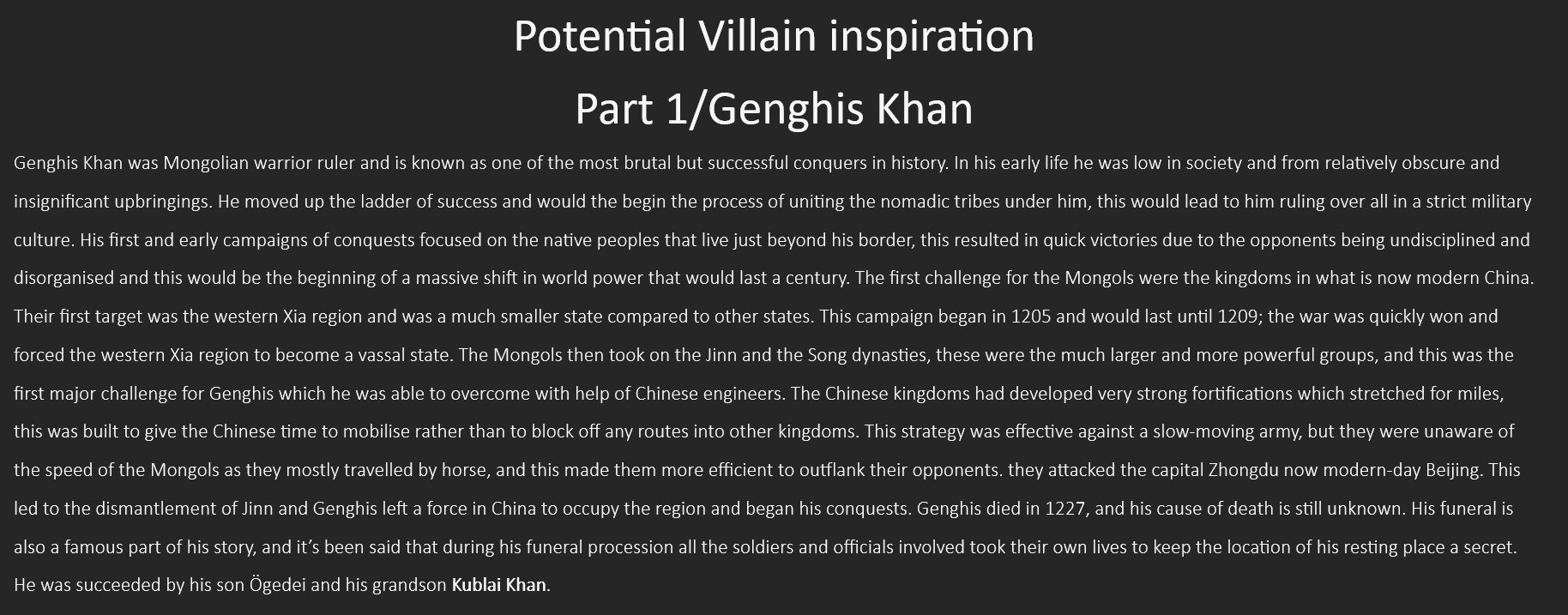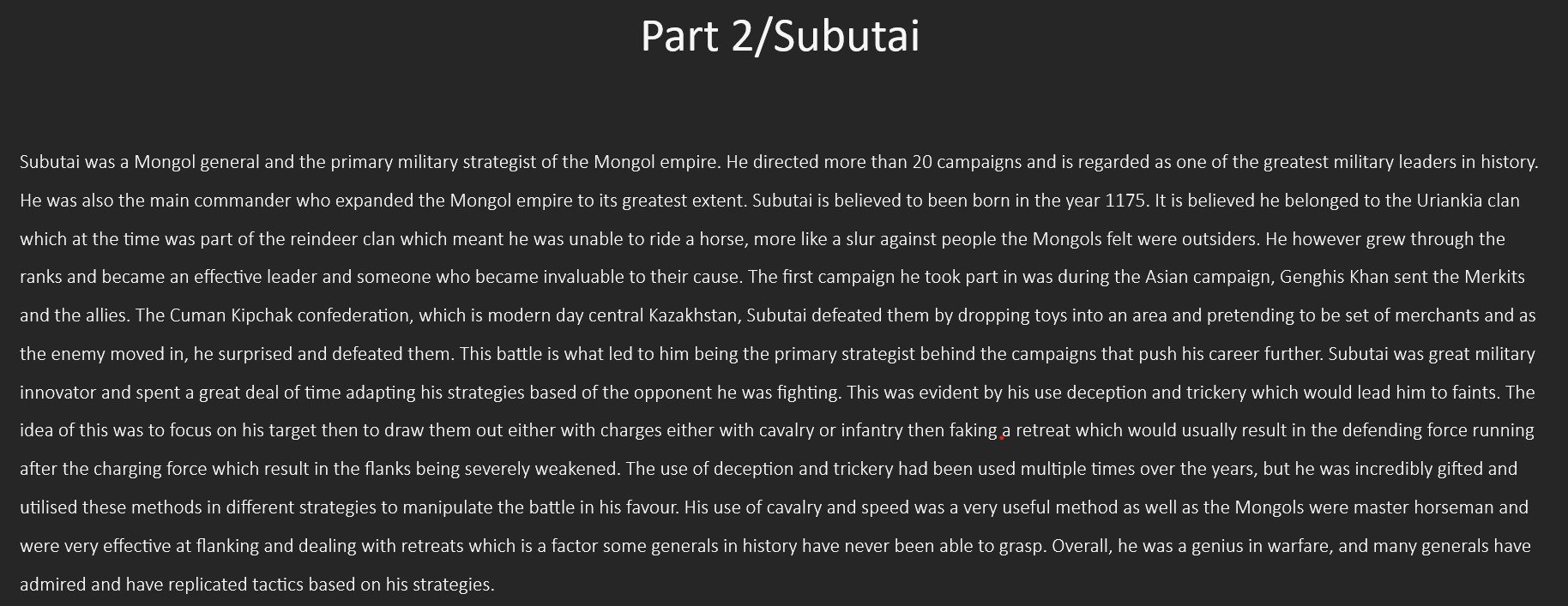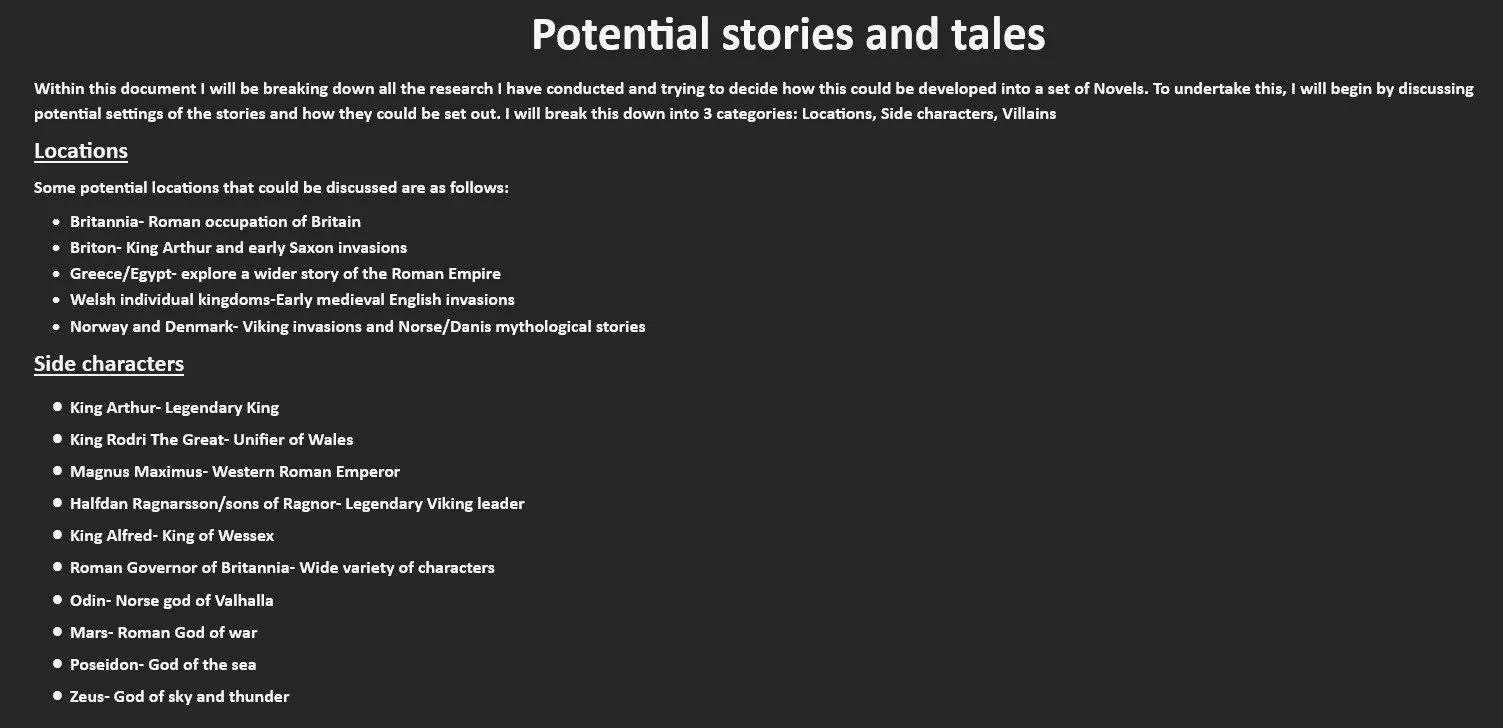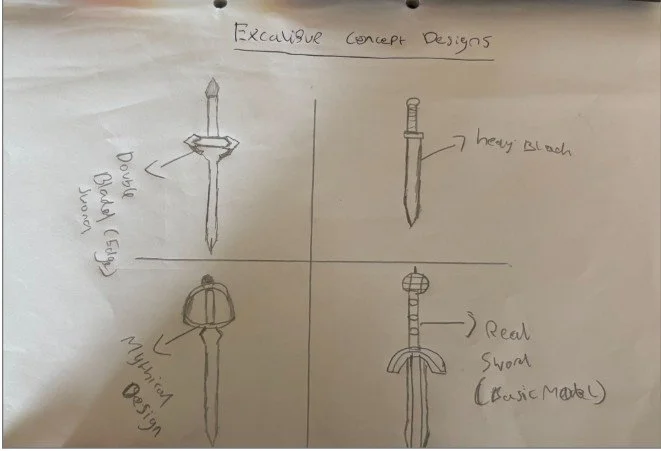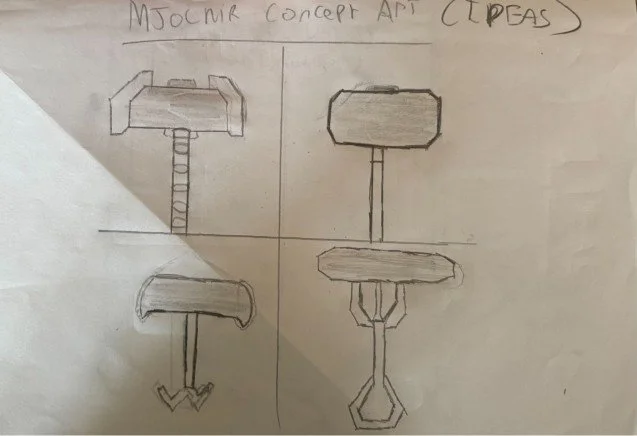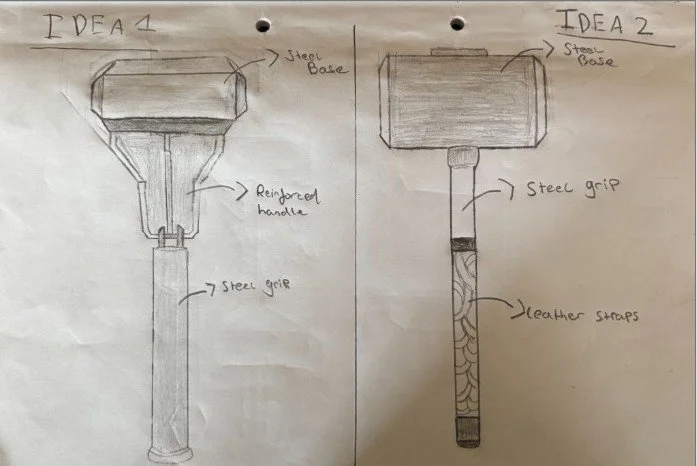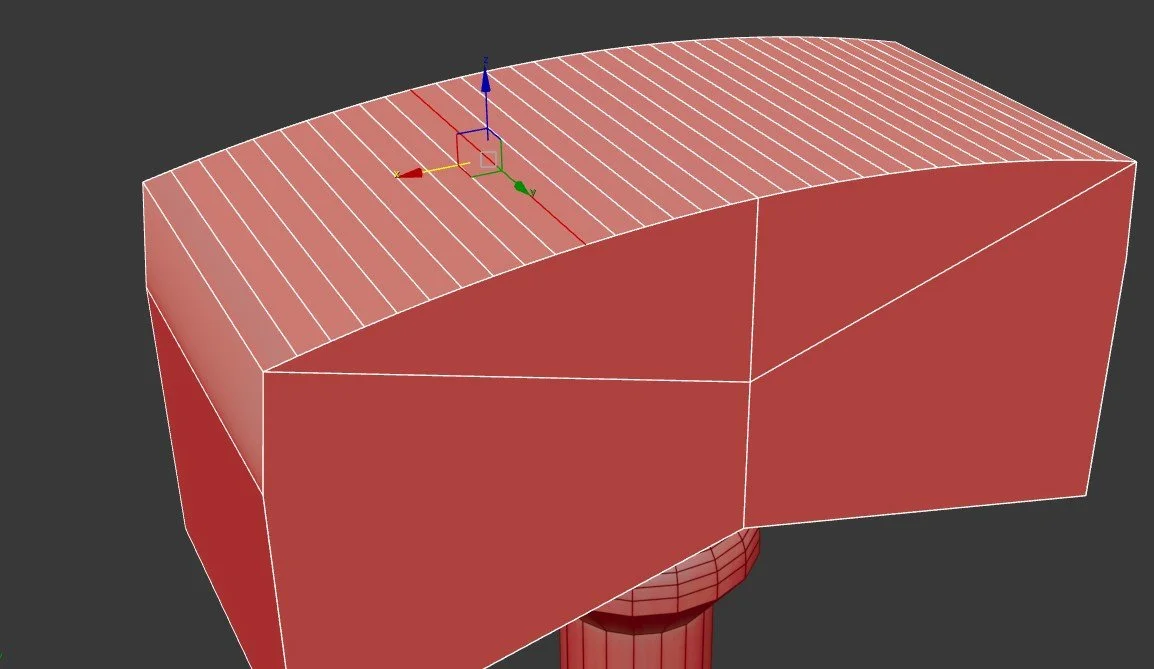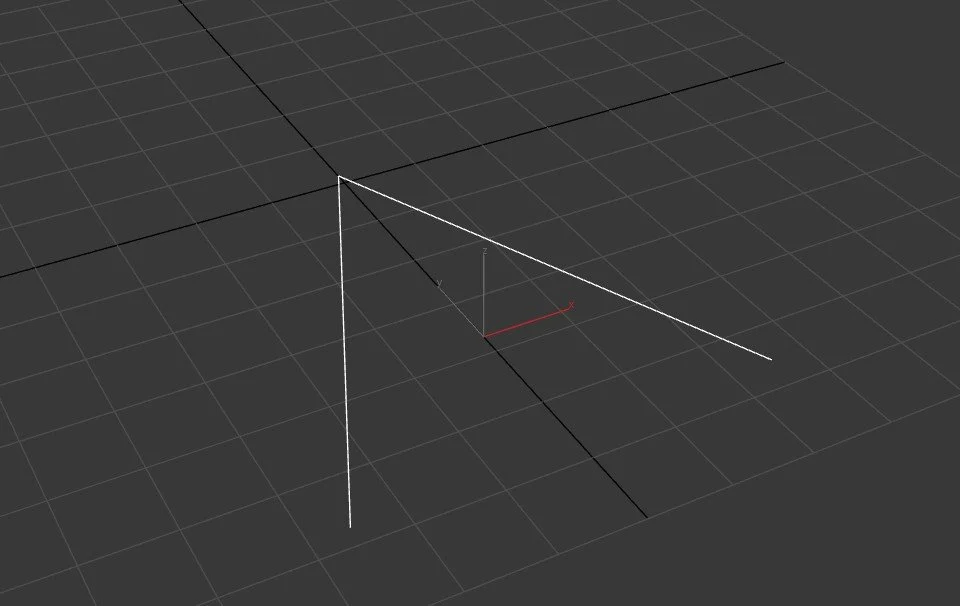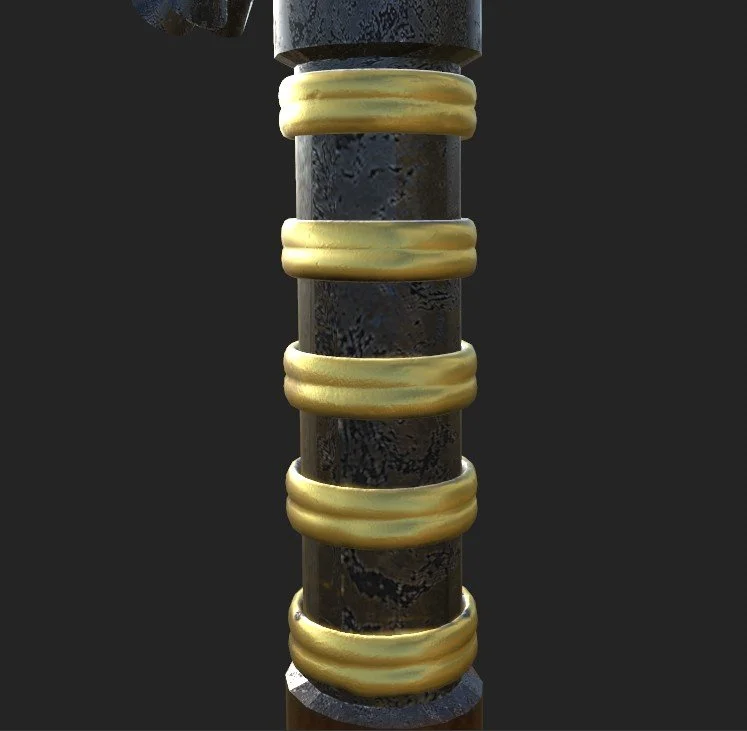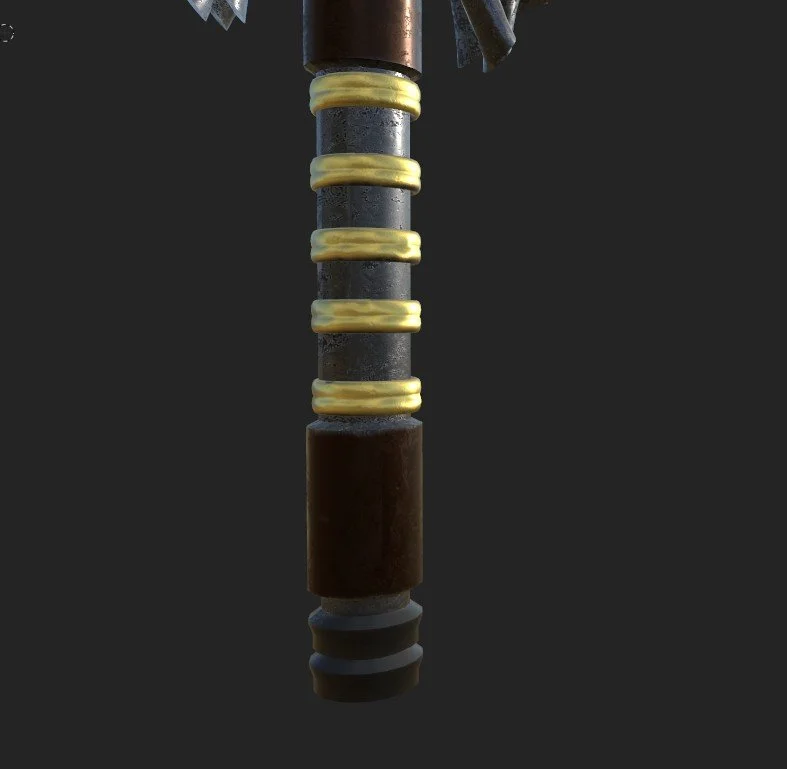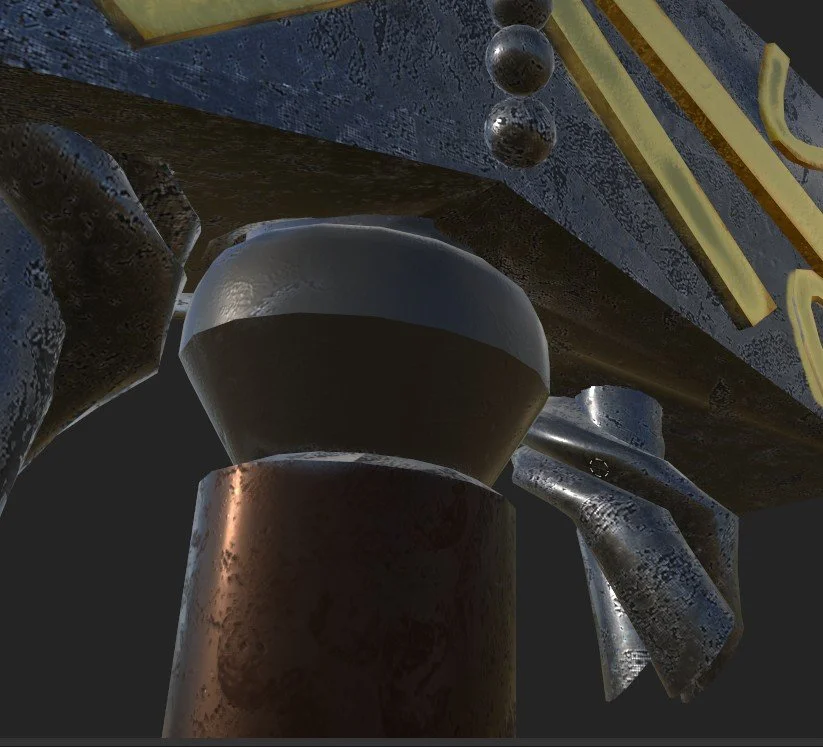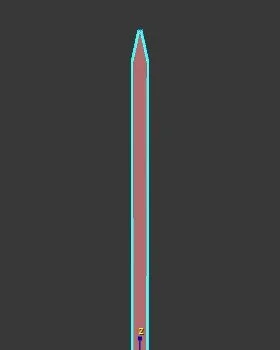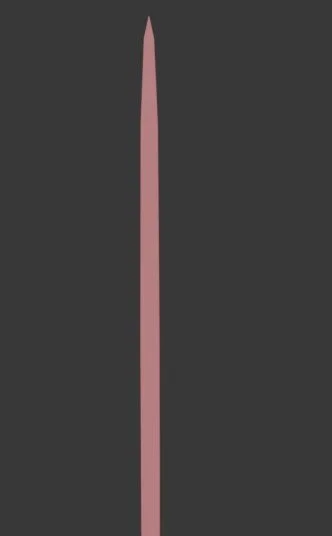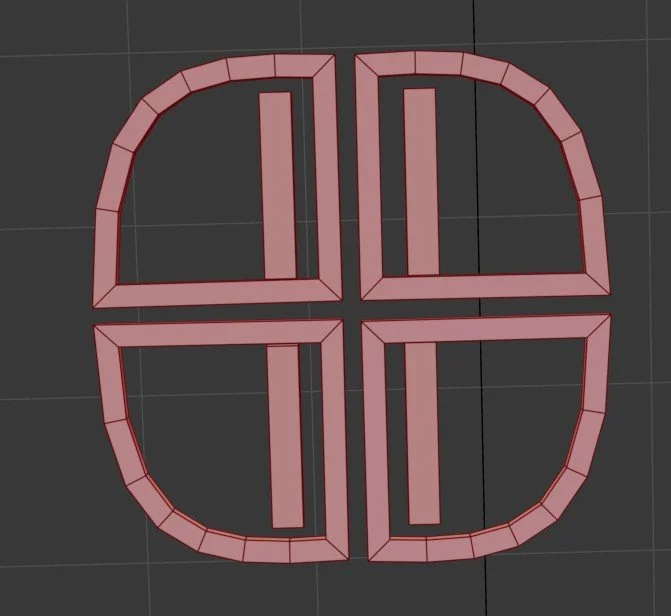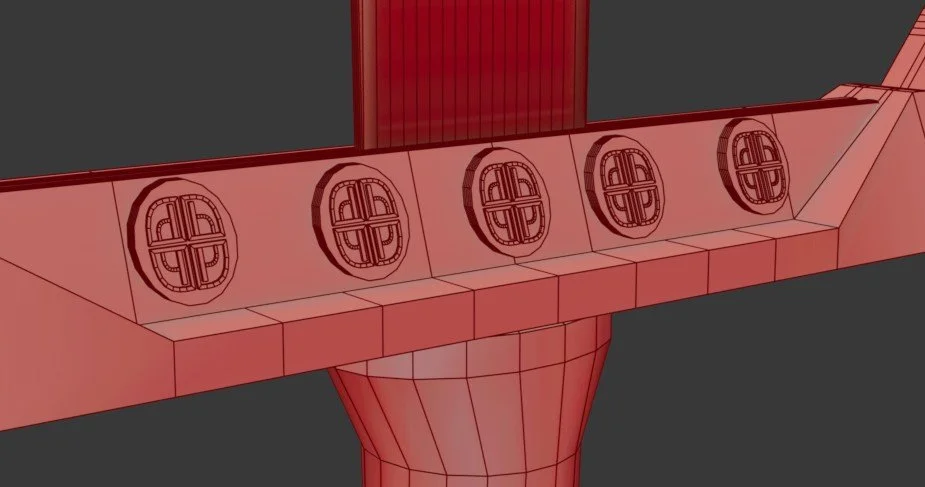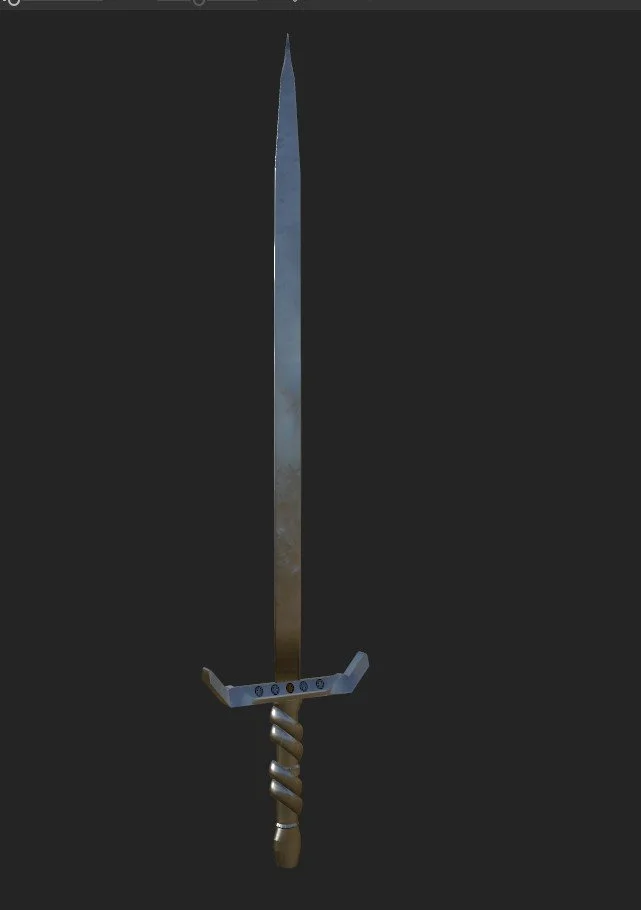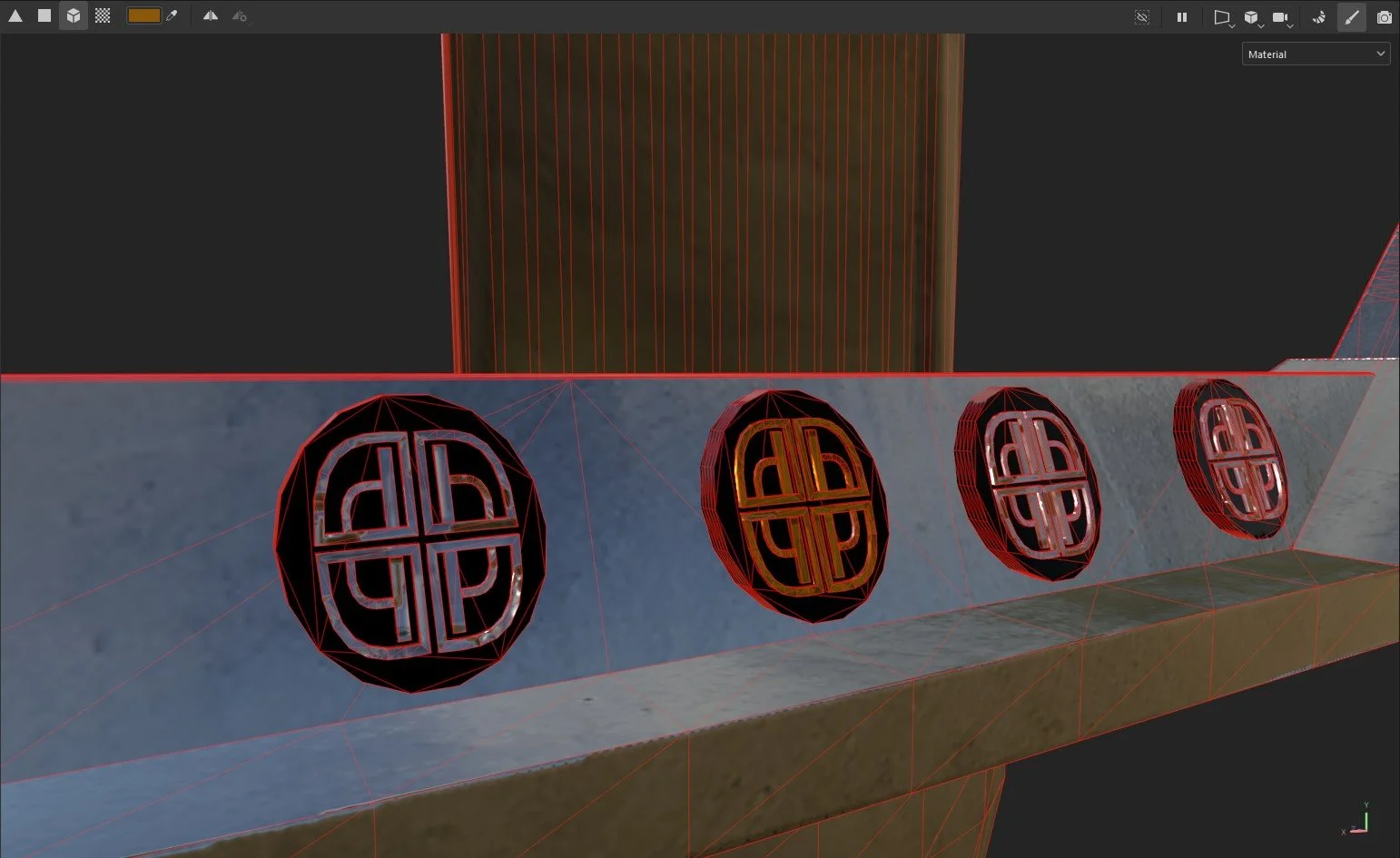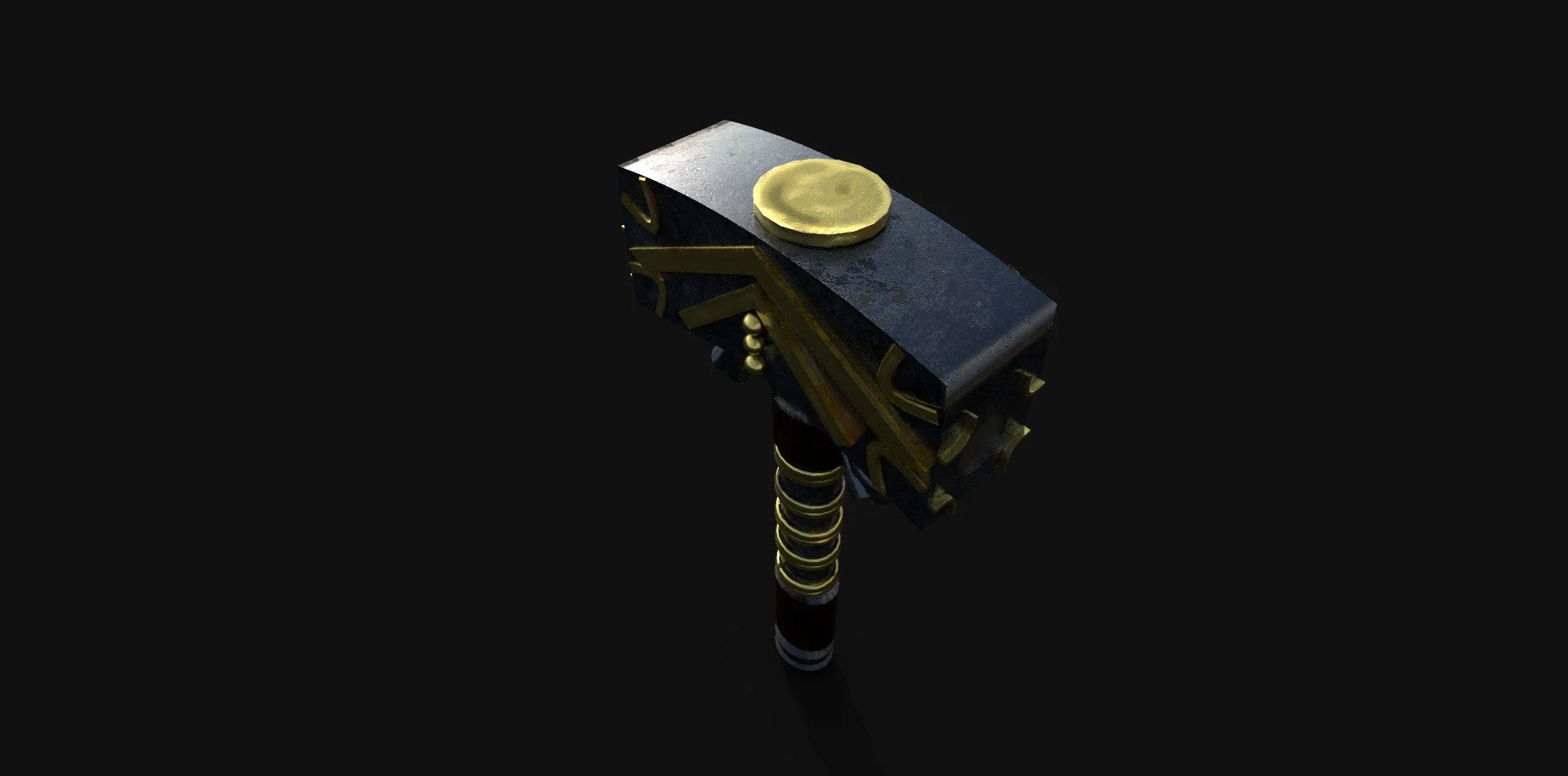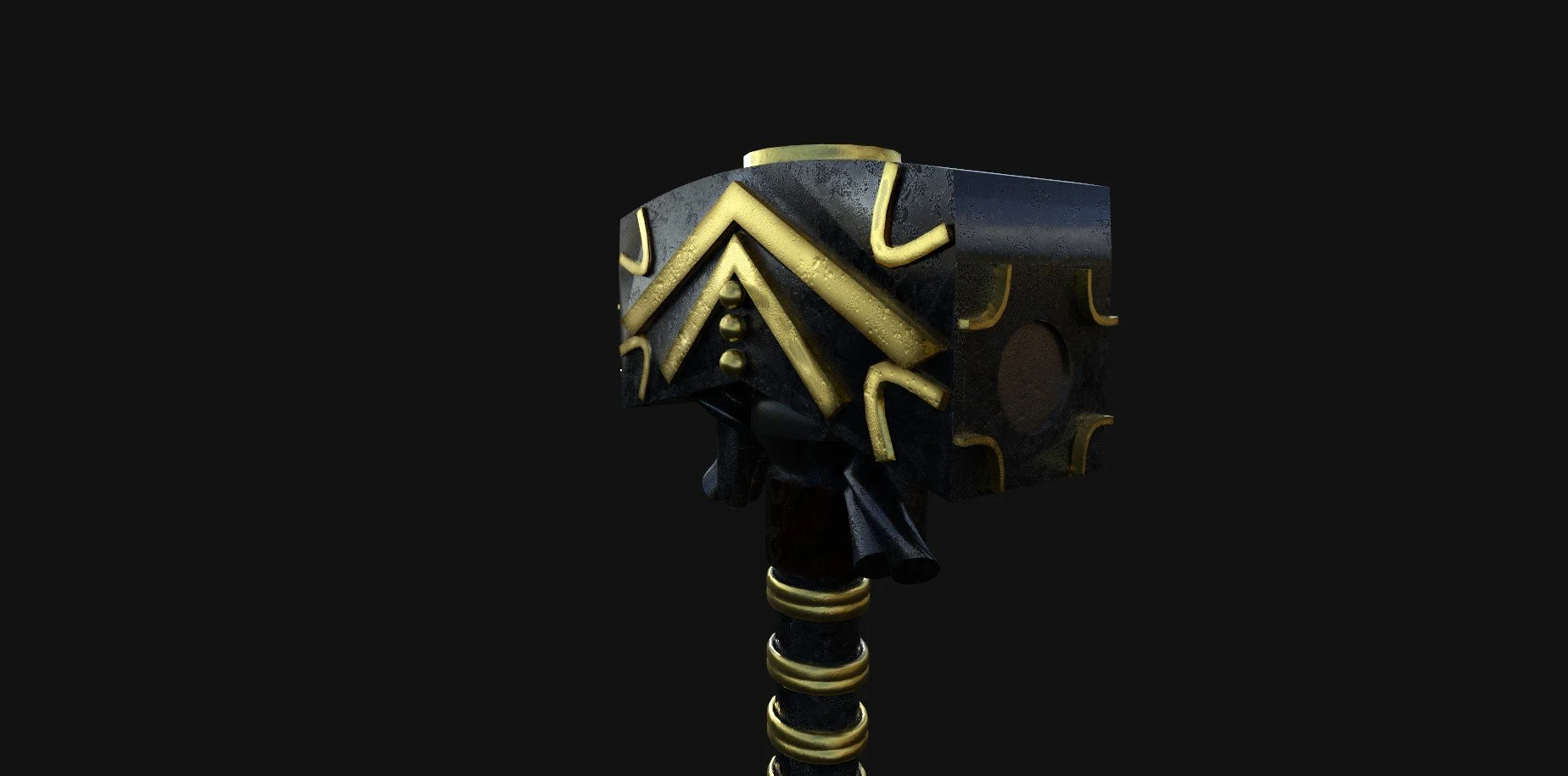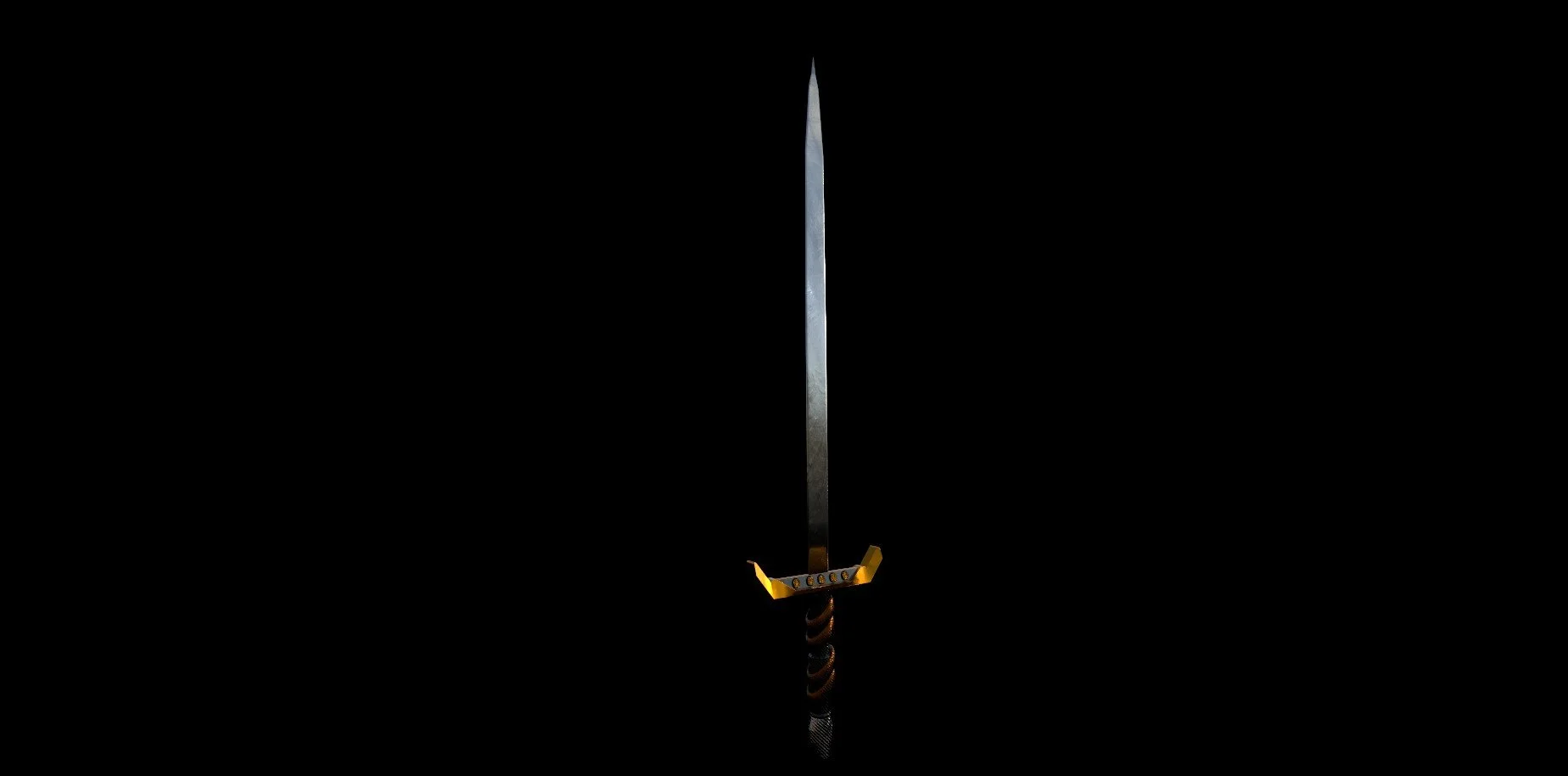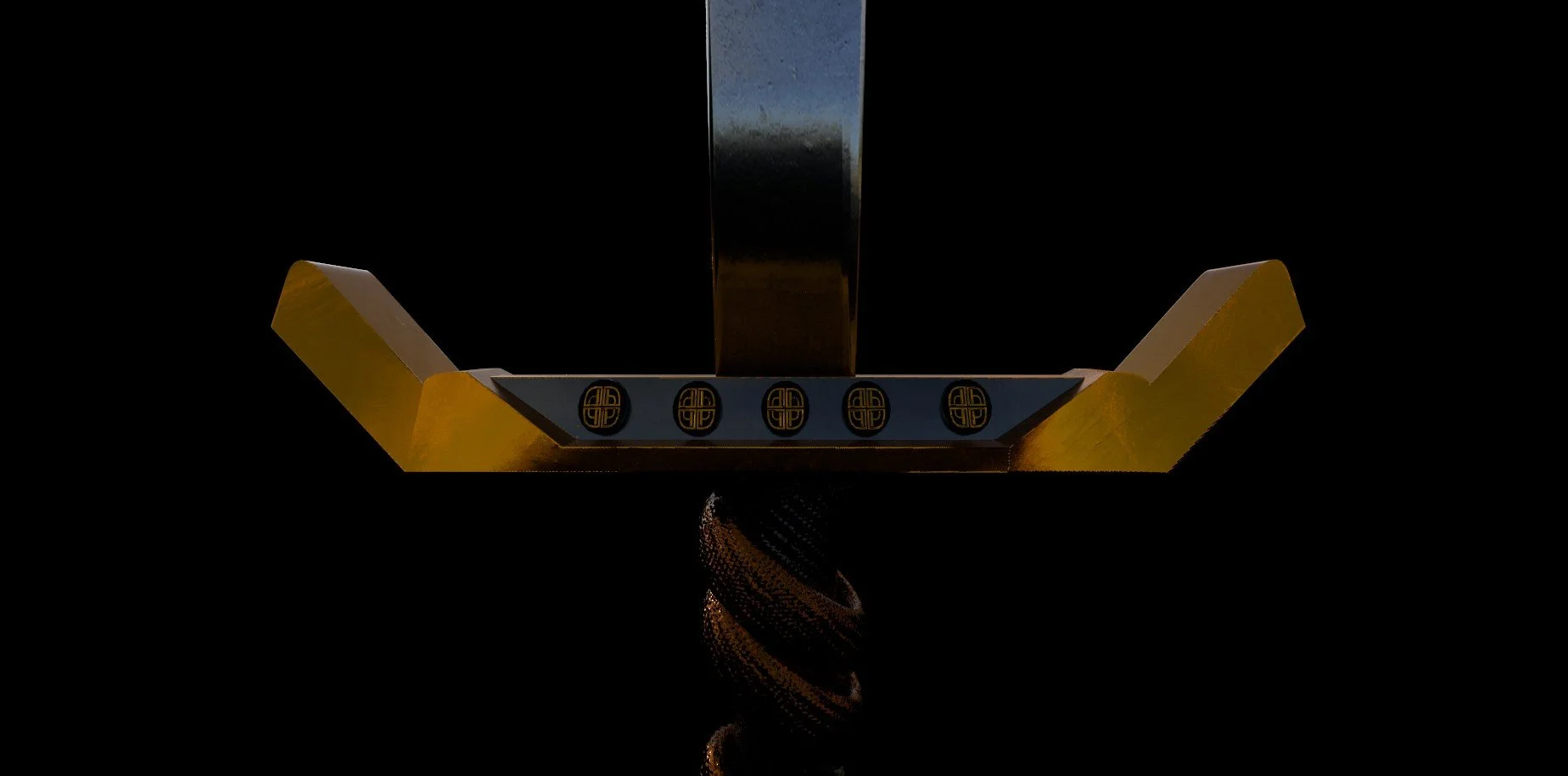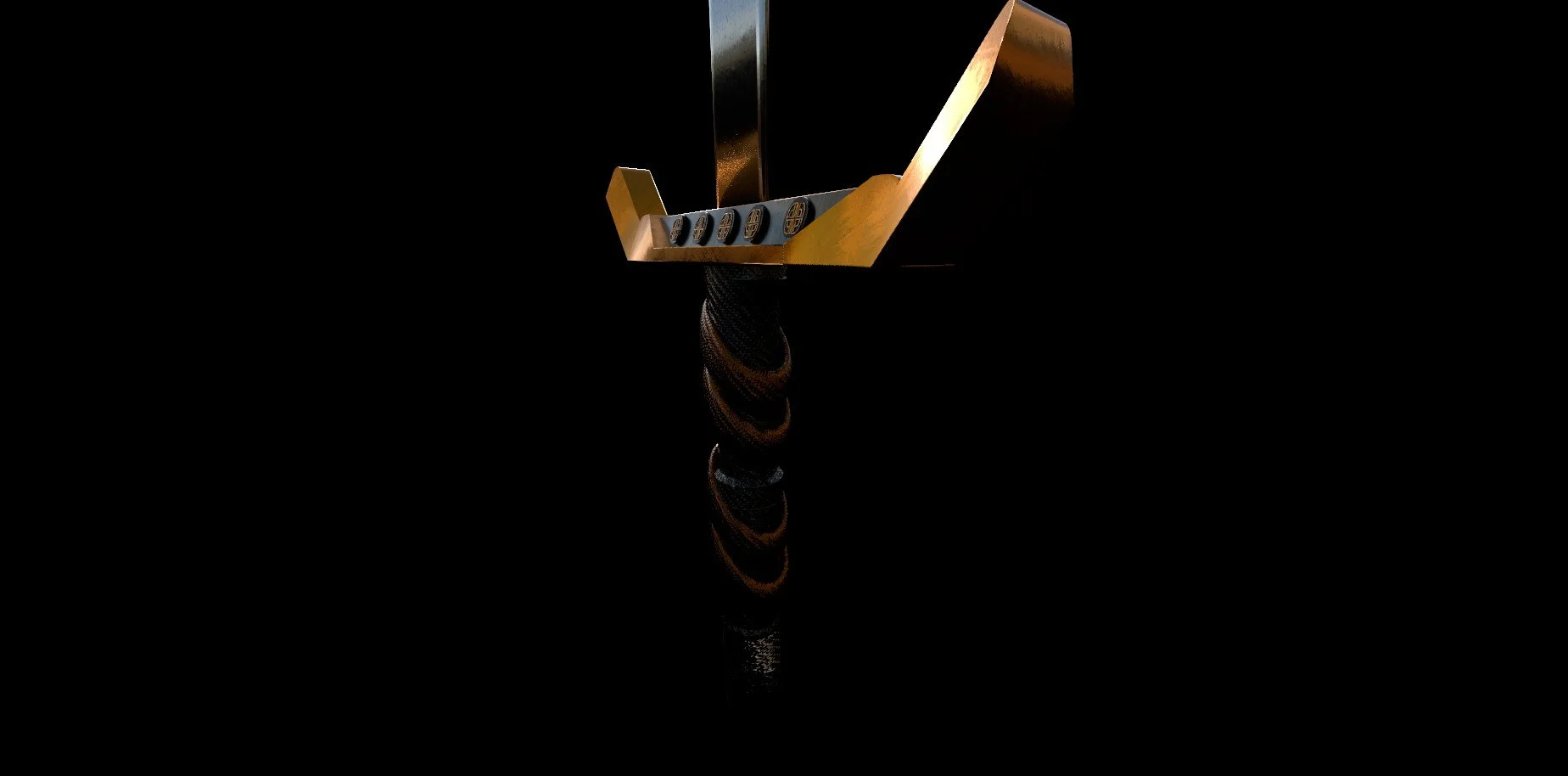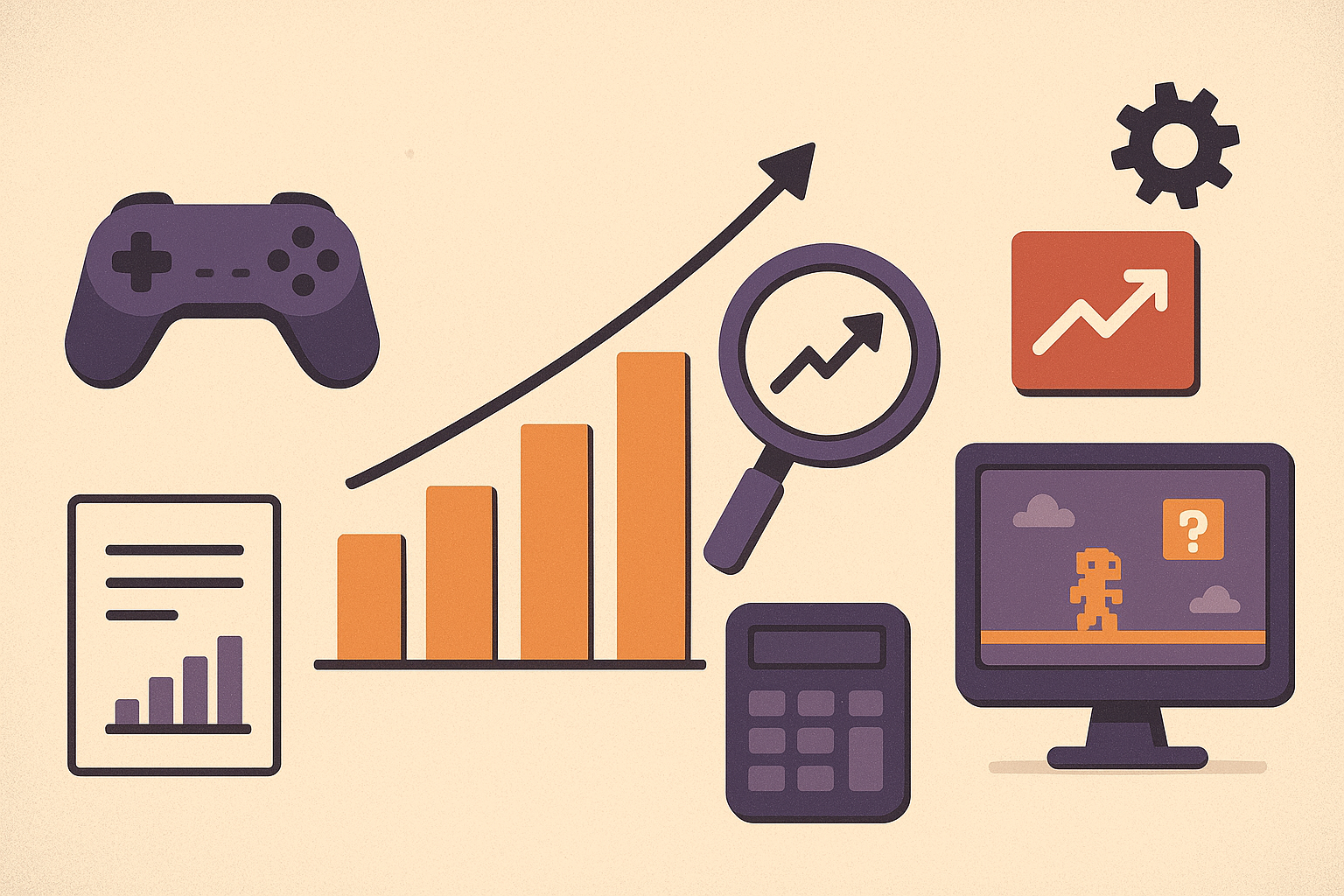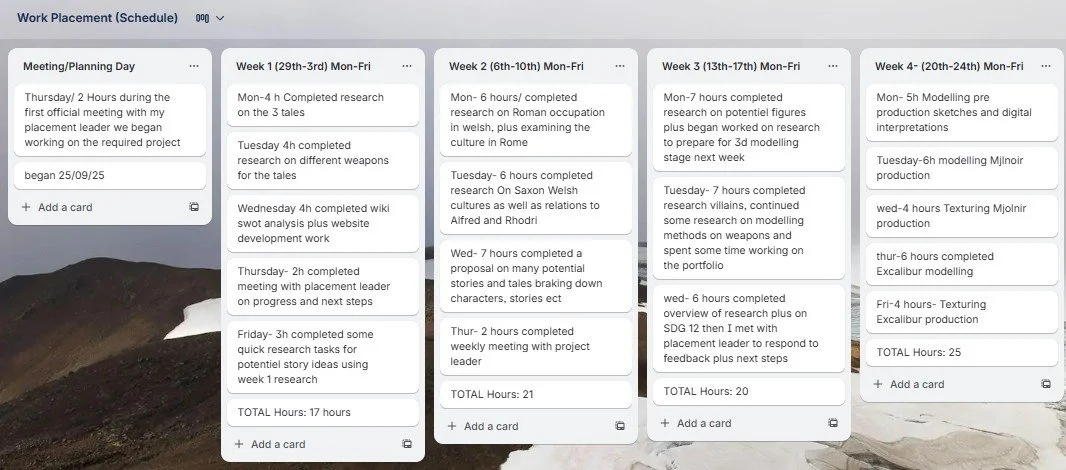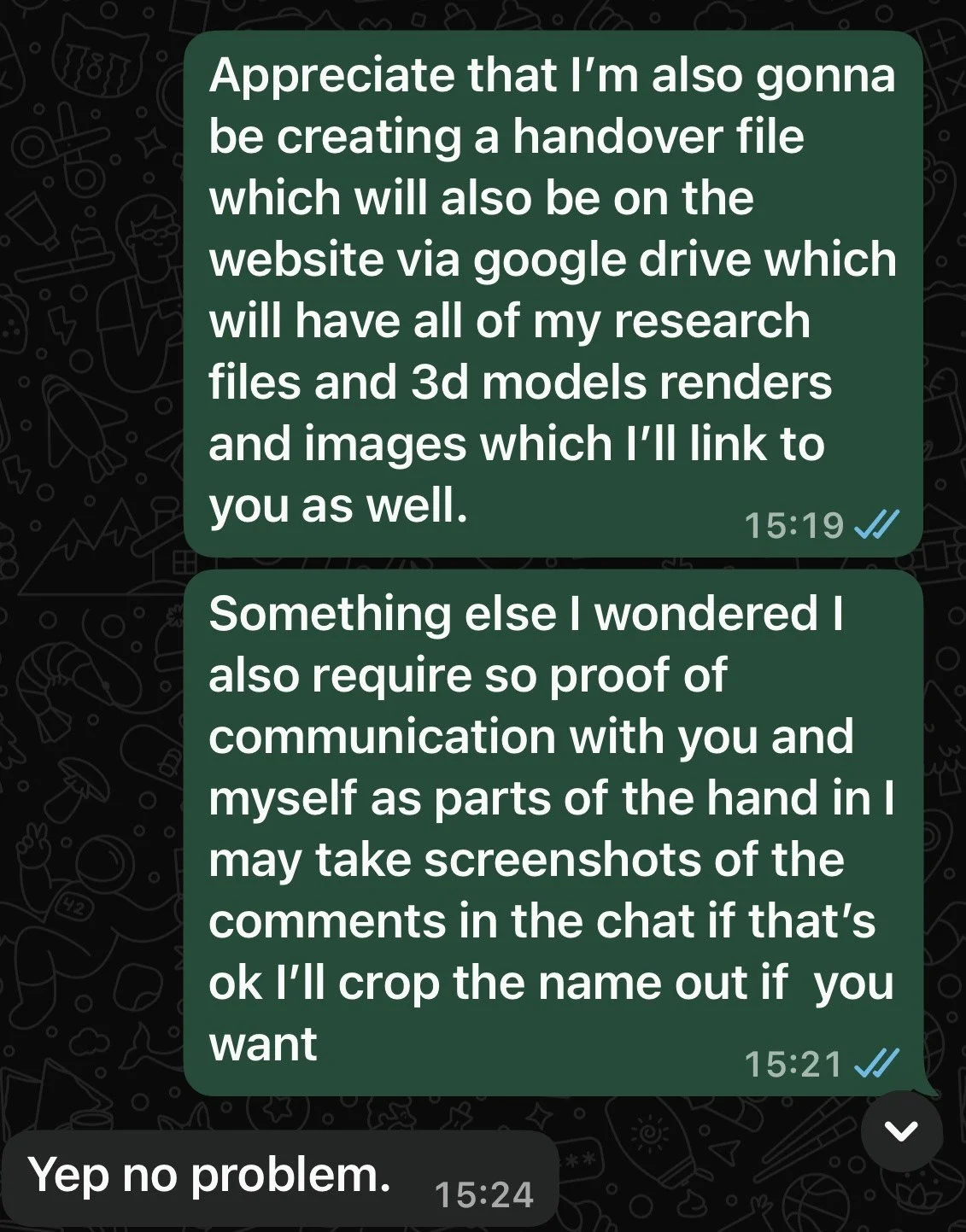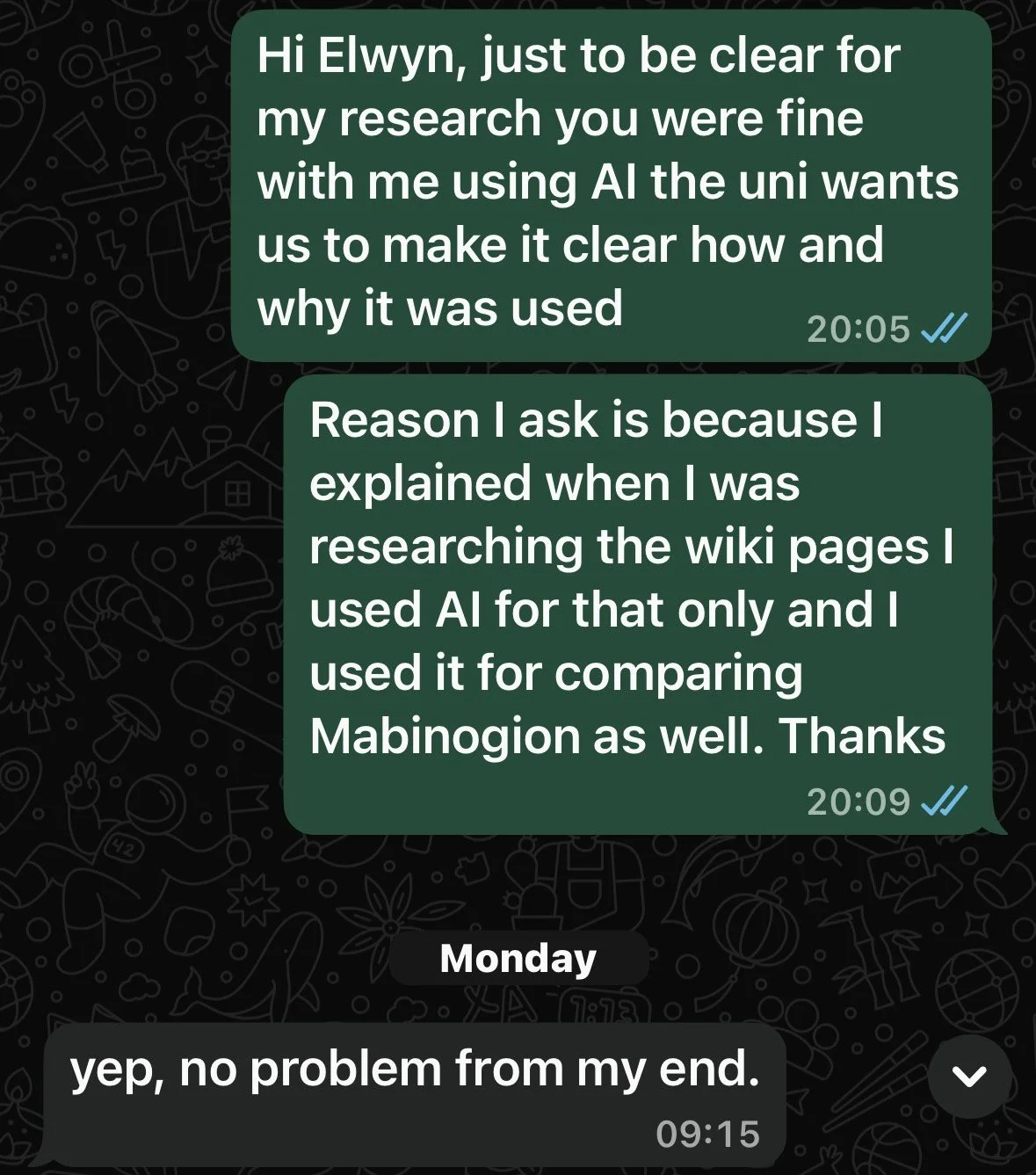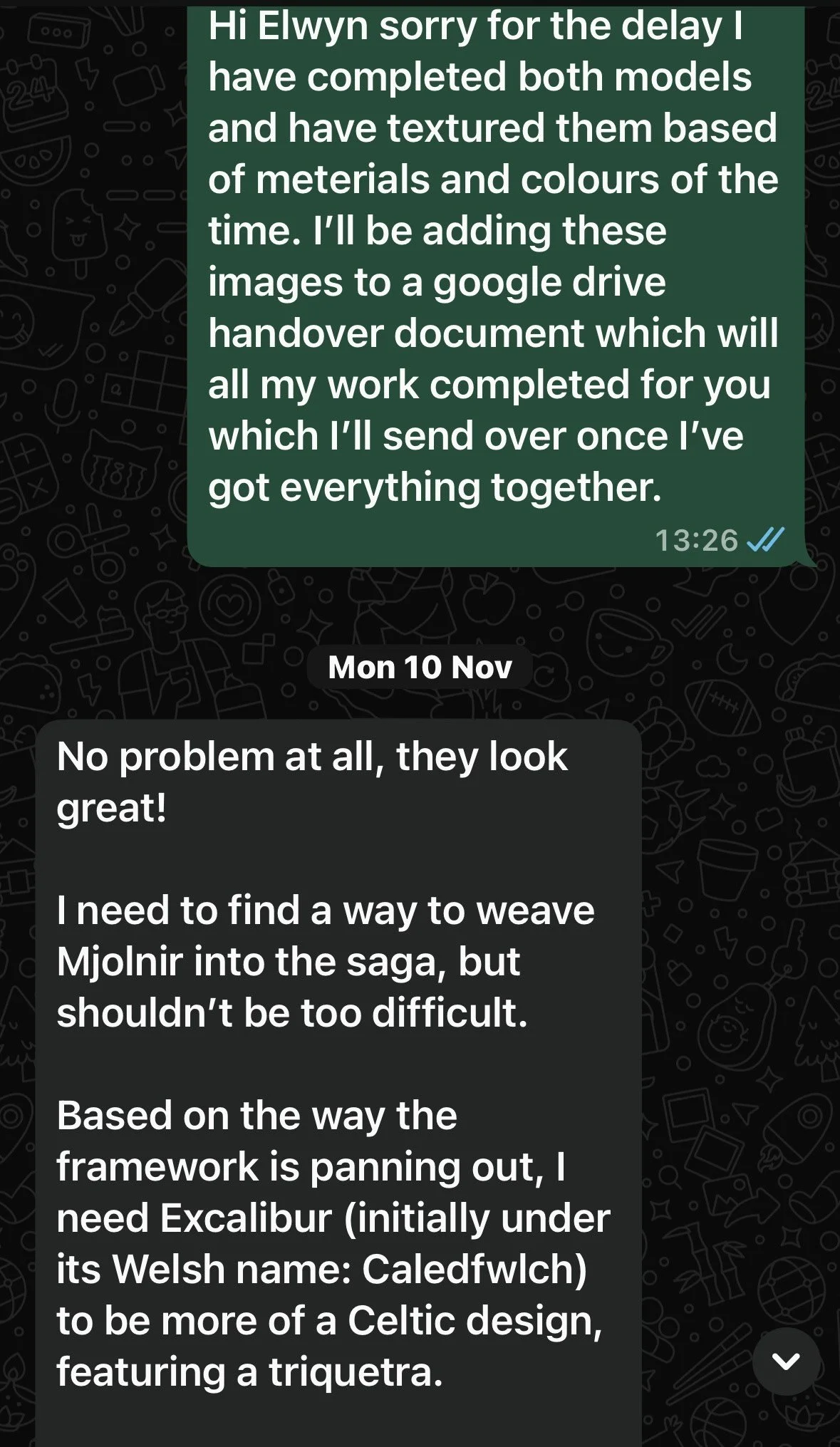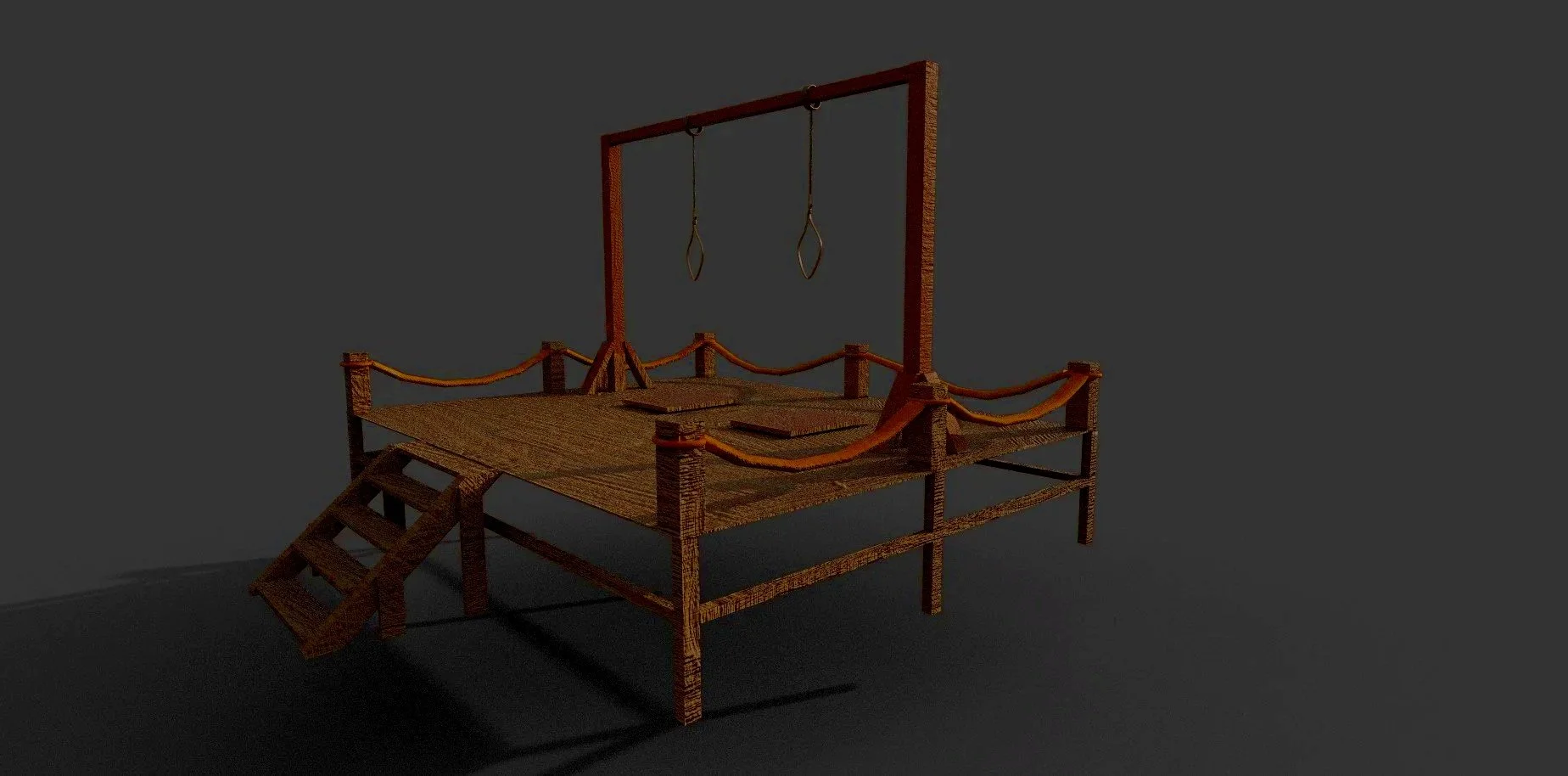
Work Placement (Pixel Haze)
Negotiated design placement (DM3108)
Project Synopsis
This page will give a clear and concise display of my time at my work placement working with Pixel Haze. This company typically specializes in developing websites and the general digital media industry. My placement leader gave me the opportunity to work with him on a personal project which will allow me to work with new skills and software but also to improve current skills, technical or soft. My purpose of this project is to help work on a set of novels based on the Mabinognion which is a set of tales and stories based on Welsh culture and literature.
The tasks I have been given are as follows: Historical research and 3d Modelling . The historical research will be conducted so he has reliable information and he has enough content for developing the novels. Once this research is conducted I will begin the 3d modelling stage which will focus on developing two 3d models that fit nicely within the novels and stories and to fit the themes. The reason for developing the models last was mainly because I would not have my PC with me so I would wait until I was due back before I would begin. The modelling stage will focus on sketches, blackouts in progress shots and finally the final renders of the assets. I will explain how I developed these models with clear annotations, I will be also using this method with my sketches so i can explain measurements and potential colour designs of the texturing stage of the model.
For this project I will be also including SDG goal 12. This one focuses on sustainable consumption and production patterns. this means I will be discussing how my work can utilise this sdg goal and through the practical work as well written work where I will link it to my historical research and I can then discuss how the research I did was able to support my links to this goal. I will also through project be discussing how it links to the modelling by discussing the values of this specific sdg goal in relation to modelling. In terms of AI i will explain how and why I used it. Any image that have been generated by AI will be explained and annotated and are their to act as aesthetics to make the website look better and more connected to the specific project
Table of Contents
OpenAI (2025) ChatGPT – Image Generation (Version 5.1) [Large language model]. Available at: https://chat.openai.com/ (Accessed: 17 November 2025).
Project Synopsis
Literature review
Methodology
Research Tasks
4.1 Novel research
4.2 Weapon concepts research
4.3 Wiki Creation
4.4 Roman research
4.5 Anglo Saxon research
4.6 historical figures research
4.7 Potential stories research
Modelling Tasks
5.1 Quick paper sketches
5.2 Final Paper Sketches
5.3 Digital Sketches
5.4 Mjolnir modelling stage
5.5 Mjolnir texturing stage
5.6 Excalibur modelling stage
5.7 Excalibur texturing stage
5.8 Mjolnir final renders
5.9 Excalibur final renders
Analysis and Evaluation
6.1 Research analysis
6.2 Modelling Analysis
6.3 Time management
6.4 Placement leader feedback
Conclusion
Handover document
8.1 Updated NLT form
8.2 Updated CV
References and bibliography
2. Literature Review
OpenAI (2025) ChatGPT – Image Generation (Version 5.1) [Large language model]. Available at: https://chat.openai.com/ (Accessed: 17 November 2025).
This projects required the investigation of multiple historical cultures and communities. I reviewed sources discussing: The Mabinogion, Welsh and Briton history, Roman history and finally weapons and characters. These were the main research tasks that would be needed for the novels so the placement leader can utilise them effectively. Academic texts and credible online sources were used to help inform me on the modelling task where I will be creating two 3d models that have a close link to the stories and tales needed. I was also encouraged to use my own historical knowledge and this will be crosschecked to ensure reliable and accurate research is delivered to my placement leader. each project will include reflection of SDG 12 and how I tried to link this to both the research and modelling tasks. Any research conducted using AI will clearly outlined as well as the reason for using it however I do expect it to be minimal.
3.Methodology
OpenAI (2025) ChatGPT – Image Generation (Version 5.1) [Large language model]. Available at: https://chat.openai.com/ (Accessed: 14 November 2025).
This project followed a research led methodology. the research stage was conducted focusing on secondary sources to establish a reliable and contextual foundation for the 3d assets. The modelling process was conducted using the common pipeline of: Sketches and ideation, development of work and final renders. The research I will be doing for the modelling task will also be secondary and will likely only be used if I encounter technical issues. Any skills, new or old will be documented during my development of work stage where I will document what I did and why I did it. The modelling software I chose to work with was 3DS Max and for texturing I used Adobe Substance painter. I chose these options firstly because I am they are both have a great deal of tools and flexibility but they also are what I am most familiar with. Each modelling and research task will be documented using screenshots and short annotations which give a brief overview of the tasks individually. With regards to AI I may use it crosscheck research or if their something that I feel requires it. My placement leader also stated that he is happy for me to use as it may become useful for certain research tasks that become harder or more complex. however I will plan to only use this as a last resort if their is something I am not familiar with. any images that are not mine will have a clear annotation below them like the one within this section which was generated through Open AI. I felt the need to include images that felt connected to the section I am discussing but also that bring a nice aesthetic that relates the project. I will now show you the first task provided by the placement leader which is the historical research task.
4. Research Tasks
OpenAI (2025) ChatGPT – Text Responses for Research (Version 5.1) [Large language model]. Available at: https://chat.openai.com/ (Accessed: 1st October 2025).
4.1 Novel Research
The first stage of research was to understand the novels and stories. I undertook research by choosing three tales for my placement leader. This was to help him understand potential stories for his own novels. I was able to link this to SDG 12 by ensuring the research I conducted was ethical and reusable. Instead of consuming culture the I felt I was reusing existing cultural knowledge respectfully and by using a book for this task allowed me to validate this better. The reason I used AI for this task was because I had not heard of the book and I needed some guidance to match up with the book to see what was true and was not. The reason I felt this was helpful was so I could become more familiar with the book and the background of it. The academic source for this was from a copy of the Mabinogion itself. I also have been diagnosed with autism and have sometimes found it difficult to break down large amounts of text. This method helped me understand the book much better and when I came to researching from the Mabinogion directly I was able to match up what was correct and what was not. I found the process much easier using this method. Below is the research from both AI and my main academic research source The Mabinogion.
ChatGPT
The Mabinogion
4.2-Weapon concepts Research
The second set of research was focused on researching potential weapons that could be included in the novels but also weapons that I could potentialy 3d model for the website to help fit the themes of the project that is needed.
While researching the chosen items I knew that the placement leader requested some items that are all connected to each other. For example both swords that i researched are both mentioned in similar stories with the Mabinogion which meant from that perspective their are plenty of opportunities for research.
As my game designer strength is modelling I also looked at what would be the best choices for developing the model. I decided I would focus on two models and decided to create the “Sword in the stone” (Excalibur) then the second and last model will be “the Mjolnir” my reason for these choices were firstly I had already designed a gladius and secondly I believed that they would both offer me unique challenges weather that would be lack of references or interpretations or simply having a lot of material which would require more of through design choices. I discuss this more in the modelling stage.
4.3 Wiki Creation Research
The next set of research is focused on researching the best sites for creating suitable pages to focus on external lore and smaller stories. The main source of this research was through AI. Firstly my placement leader said this may be the best way to do it as neither me or him and worked with Wiki software before. To understand the platforms we used AI to create SWOT analysis that was then used to support decision making in deciding what would be the best software to work with.
World Anvil
LegendKeeper
LoreKeepers.IO
Notion
Scrivener
OpenAI (2025) ChatGPT – Text Responses for Research (Version 5.1) [Large language model]. Available at: https://chat.openai.com/ (Accessed: 3 October 2025).
4.4 Roman Research
The second week of research focused on studying the cultures of Rome. This will be conducted by Focusing on the Roman occupation of Wales and then I decided to focus Roman culture in general. I will look at: Military, Government, laws and general living conditions.
4.5 Anglo Saxon research
4.6 Historical figures research
The final set of research before i began working on the modelling work was to think of certain fugures in history that may be perfect for designing a character. The idea from the placement leader was to think of someone who was known as a brutal conqueror but also someone was politically sound. I chose 4 figures from history who I believe would fit the potential stories
4.7 Potential stories research
I was asked in this section to understand what potential stories that could be created from the stories i discussed. To complete this I split this up into side characters, locations and finally villains.
5.Modelling Tasks
5.1 Quick paper Sketches
The first task was to brainstorm some potential ideas and sketches. The two modelling projects I have agreed to work on are focused at two mythological weapons associated with the story and potential characters. Mjlonir the hammer of Thor and finally Excalibur. Both of these weapons have different iterations and I chose these designs based of some images I found online. All references and sources will be added at the end of the project.
5.2 Final paper Sketches
Before I begin with the modelling I decided to narrow my choices down to two potential designs. I plan to also digital sketch my choices. The focus from the placement leader was to design something that is noticeable to cultures and then also something more grounded. This means as I develop the project I will need to keep that In mind. One of the reasons I decided to go for this method was to first show a interpterion of skills and then to have some ideas to build on and also was to support the sdg goal 12 which focuses around sustainable consumption. By sketching on paper I wont be using technology anywhere near as much as it would be when it comes to the digital work.
5.3 Digital Sketches
The final ideation ideas are below. After speaking to the placement leader I was told that from the story perspective he wants the final designs to be slightly more grounded. the designs I chose 2 weapons that while are based of mythological stories can still be intercepted and viewed differently which means i can use different designs.
Stage 1
5.4 Mjolnir Modelling Process
The first stage of modelling the hammer required to create the hilt at the bottom of the hammer. This process used the extrude tool which was to enlarge the area seen and then I would use the chamfer tool to create the bend required.
Stage 2
The second stage was to do the similar task for the base of where the hammer will be located. I extruded the top and then began working with the chamfer tool again and this would create a solid step for the hammer to sit on.
Stage 3
I then began working on the hammer by creating a new shape and then creating the curve, while sketching this idea I did originally think of going for a flat service but after doing more research on illustrations I decided to go for the curved top and then this gave me more freedom to make it while also taking into account what was required from the placement leader.
Stage 4
The next step was to begin working on the symbols and designs which I found from reference images and research which are designed and placed on different sections of the model. I completed this stage by using the line tool
Stage 5
the edges on the side are to create more design iterations which would either be covered in gold or silver for extra style and creativity, not to mention the model is based of a mythological design. This was once again achieved by using the line tool and the circle is created by using the Boolean tool to create the tool which was perfect for creating the extra detail
Stage 6
The final step was to add some golden rings which will act as a source of expensive and mythological feeling and is their to act as a position of prestige which was important for Mjolnir which is seen as an important in Norse mythology. To achieve this i used the torus shape to go around the grip.
5.5 Mjolnir texturing stage
Stage 1
The first step of texturing is to think of potential main materials that work as the base texture. I decided on a dark metal which is more focused on the realistic side. The reasoning for this because the smart materials are perfect for adding effects and detail like scratches and dirt which at least matches creative fidelity but also aligns it into war and conflict.
Stage 2
the second step was to add a lighter silver texture across the base of the model which gives it more variety to the rest of the model, I then added some yellow to the shapes to make it more golden and to make it look more expensive and prestige but also to maintain a mythological feeling.
Stage 3
The 3rd step was to add the golden texture to the rings which I did by choosing a golden painting texture which I then carefully painting around the rings which was important for not having paint all over other parts of the model.
Stage 4
While analysing the model I decided to add some more detail to the gold like I had done with the rings to make the base material which gives it more substance and makes them standout more. this was undertook the same way as I did with the rings.
Stage 5
Too add some more accurate historical detail I decided add some wooden detail which works alongside the steel. To also mention SDG 12 I made an effort to think about a lot of the materials and consumption the planet uses which means that by including wood it is less damaging than using modern equipment drilling for more expensive materials. Which is why I only used small amounts of gold or rarer materials.
Stage 6
I finished the texturing process by adding some smoother materials to different parts of the model which included adding some darker tones to the handle and bases and also then adding some slight scratches and making the model look more appealing.
5.6 Excalibur Modelling stage
Stage 1
The first step of developing any sword is the hilt. I began working on the design by studying my sketches and I then began creating the visual designs like the hilts middle section and the lower section. this design required tools like Chamfer and extrude which I used for modelling the hammer however this was in slightly greater use as I used the monolithic workflow to build the hilt.
Stage 2
The next step was to model the blade holder on top of the sword, one of the requirements for this was to make the 2 sides sitting out curved at the edges which I could do with the chamfer tool, this can be done with using the bend tool but this can cut into the poly and this can interfere with the typology. I also used the Boolean tool to cut a hole where the hilt can sit into the handle.
Stage 3
the blade was created by bringing in a new cube and then extruding it up. This then allowed me to move the vertices to then create the shaper end at the top. To keep SDG 12 in mind I made sure that different parts were optimized well and not heavy poly counts which lowers the energy use and supports sustainable digital practice. the blade above was very low in terms of polys.
Stage 4
To make the sword look more realistic I decided to use Turbo smooth which can make the sword much smoother and this offers a range of texturing options as textures will appear much better due to this change.
Stage 5
The Line tool was used to create the Britons symbol. This method is perfect for creating and simplifying objects and this also can be effective for designing complex objects. this can also be connected with SDG 12 as this tool can be used to create clean and efficient base geometry which help save computer power which leads to more sustainable modelling approaches. I also felt this method was the best for this particular task and it does suit the SDG 12 approach.
Stage 6
The assets are then cloned and then placed on both sides of the model. This was the main skill that I wanted to improve and this was also something the placement leader requested which was to link the sword directly to the Briton culture. This does link to sdg 12 because one of the targets is reusable materials and sustainable production and by reusing assets I am avoiding waste and duplicated data.
Stage 7
The final task was to include leather straps which were undertook by using torus shapes and then I rotated them so they could act as the straps which are designed to give more grip the user. One of the challenges was to make sure these did not interfere with the typology
5.7 Excalibur texturing stage
Stage 1
The first aim like Mjolnir was to create a smart material and then use that as the base material for the blade. I chose a steel stained material which contained scratches and a light silver colour.
Stage 2
I next began texturing the Briton symbol which was was typically designed using a black background with a gold tint through the 3d line parts of the model. I used the polygon selector tool to do this accurately and to avoid cross texturing onto other parts of the model
Stage 3
the final focus was to add some small details to the hit and to the blade. I had to make sure that no textures were overlapping or any polys were not giving the write impression. I also added the brown texture to the grips and I made sure the blade had a mixture of smoothness and scratches
5.8 Mjolnir Final Renders
Below are the final renders of the modelling process, I will breakdown everything in my analysis and reflection section.
5.9 Excalibur Final Renders
Below are the final renders of the modelling process, I will breakdown everything in my analysis and reflection section.
6. Analysis and Evaluation
OpenAI (2025) ChatGPT – Image Generation (Version 5.1) [Large language model]. Available at: https://chat.openai.com/ (Accessed: 17 November 2025)
The research tasks had mostly positives but also small negatives. Firstly the history I researched was very much in my strengths and my interests which kept me attentive and happy with the work I was conducting. One way I used both research methods (academic or AI) was to give two main viewpoints. An example was within my novels research (4.1 novels) which was where I used both research methods to gain a strong assessment to balance a modern viewpoint to how it has been viewed in much older times. As I had not heard of the book I felt this was best way to gain quick facts where I could then match it up with The academic research via the Mabinogion directly. I used for this particular research task was via a book that contains all the tales of Mabinogion which was the key piece of inspiration that my placement leader was using. This allowed me to adapt both the book research and AI into a document where I could crosscheck to find out what was accurate and what was not. I only used AI once on its own once, this was within (4.3 wiki creation) this was because I was not familiar with this particular sector and I felt the best way to undertake this project. This is why the placement leader asked if I could create a SWOT analysis using AI where we could then agree what would be best for the company to use. The research stage was undertook on location where once a week I conducted a in person meeting to discuss progress made and what research would be needed for the next session. The benefit of these sessions was I was able to locate any mistakes or any work that was needing more refining.
The other area I focused on was how I included sdg 12 into the work. Through out the project I discussed how I could include these goals into my research process. The main objective of these goals is: responsible consumption and production. To relate this to research I focused on the consumption of cultural resources, to understand this better instead of consuming culture I was reusing and repurposing the research in a way that is respectful. For the vast majority I used reliable websites and articles as well as a documentary on Julius Ceaser which I used to help me gather research for my historical figures research (4.6). Alongside this I used 2 books which you can find within my references section. In total I used AI twice during this project and I made sure to explain my reasons for this and why I felt it was needed. Overall I feel that while not using AI would have made my work more even more directed to SDG 12 I knew that both were very beneficial and useful to how I undertook work so I am overall with the outcome of the research section.
6.1 Research Analysis
OpenAI (2025) ChatGPT – Image Generation (Version 5.1) [Large language model]. Available at: https://chat.openai.com/ (Accessed: 17 November 2025).
6.2 Modelling Analysis
The modelling process was the main practical objective. I was given a lot of creative freedom by the placement leader for modelling both weapons however their were some areas that I had to make sure I covered. One was making sure that I included representation of the culture that the weapon was associated to. For example when I began working on the Excalibur I included the symbol of the Britons which was their main symbol. Some other small comments were mainly focused at keeping everything grounded and not to mythical to make the stories feel more connected to more well known history. The other area I had to keep in consideration was SDG 12. This was more prevalent in my modelling than research and the reason for that is because I found it easier to discuss it within technical language. For example one of the ways I was able to discuss this was during the creation of symbol. I was able to re use assets which connects to the reusability goal with this specific SDG. The main limitations of this was that by modelling I am using a lot of energy and power which did effect my creative thinking. Despite this, I did make a good effort in attempting to link these challenges.
The skills I worked with were mainly focused at the usual tools like: Pro Boolean, Twist, Extrude, chamfer and finally turbo smooth. These mains skills are areas I used in both Mjolnir and Excalibur with similar styles. The modelling process was much easier than I thought and that was mainly because I was familiar with the new skills, The main new skill that I used was focused at the line tool. This tool made making certain assets much easier like the symbols much easier as I was able to create each shape and then clone them efficiently. This was where SDG 12 was greatly evaluated and used as a good portion of the assets were reused which did allow me to keep SDG in mind without it effecting the creative process.
The Texturing process had me doing a lot of trial and error. I was trying multiple smart materials to see what I felt look the best for both models. This process was slower than I thought as I had to refer to my digital and paper sketches which I had annotated to give my early suggestions and ideas. The final designs ended up with the more grounded approach and this was the main requirement which is why the textures on both models utilise very basic materials like steel or wood. I did have to take into account that despite this being more grounded from a historical perspective I did want to include a valuable material like gold to signify superiority and also make it feel more connected to the mythological feeling.
The final thoughts of this modelling process is that I was able to adapt a good portion of my research and my own historical knowledge was improved and used in the best way possible for the modelling. My placement leader seemed more than happy with the models and I made sure to make him aware of the process and how I was doing during the project. I felt able to include SDG 12 in some way and while felt it did not massively improve or make the project less fun, I do think it was still a challenge that I enjoyed I do feel I did my best to utilise it. the skills were also very important and while I did not use many new skills I was able to be more effective at the skills I more often which overall improved my modelling abilities
6.3 Time management
The Trello board below breakdown how my time was utilised and how I was able to record the time. I was expected to conduct a maximum of 80 hours. I undertook the research on site with the company and the modelling task was undertook at home as I did not have my PC with me.
Evidence of Feedback
Evidence of AI approval
6.5 Placement leader feedback
below is evidence of communication within my placement leader. While we did conduct in person meetings we did keep in contact so I could receive feedback from the modelling as well to show progress. I also made sure to clarify key areas like: Approval to release messages and also clarifying the what we agreed as the the use of AI.
Approval to release messages
7. Conclusion
To summarize the project and reflect on it I would consider this a successful and enjoyable experience, I was able to work with a placement leader who was equally passionate around history and digital media. I spent a great deal of time learning and researching multiple historical communities which I was able to gain new knowledge and from the modelling I was able to me more creative display both new and old skills. I was able to link SDG 12 to both which I felt would be the biggest challenge.. If their were some areas I would like to have done differently I probably would liked to have used slightly less AI to make my research as more ethical however I do feel the reasons I made for using AI were justified. This project was my first real contribution to a company in the digital experience and I felt satisfied with the work I undertook.


